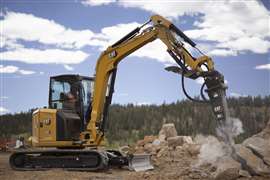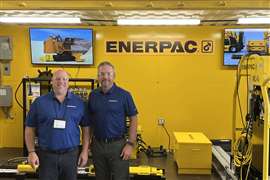End of the show
11 June 2008

Three Italiian contractors have joined forces to carry out the complex demolition work at Milan’s Fiera Milano exhibition centre. D&Ri reports
The Fiera Milano site was first established in 1923 and over the 85 years since then, a range of structures have been built on the site for a variety of purposes, with the last major work being a redesign prior to the opening of the New Portello building in 1997.
Today, elements of the site are being decommissioned and demolished, and the current work involves the clearance of around 250,000 m2 of the site, of which some 80% is covered by buildings of a varied structural nature, function and type.
Because of the scale and nature of the demolition task, three of Italy’s leading specialists in industrial decommissioning – General Smontaggi SpA, Canteri Moderni Srl and Despe Srl – have formed a temporary consortium to carry out the work.
The Fiera Milano is located in a heavily built up area, with adjoining buildings averaging 6-7 floors in height, with a mix of residential, service and commercial uses.
The buildings to be demolished have a footprint of 150,000 m2 and a total surface area of 2,500,000 m2. Materials to be found on site include 230,000 m2 of asbestos and insulation materials, a total volume of concrete and other building materials of 350,000 m2, 250,000 m2 of paving and a large volume of mixed construction waste. The demolition and waste processing has to be done in the shortest possible time, while at the same time all appropriate regulations must be fully observed and the impact on the nearby residents and businesses, and the local road network, must be minimised.
As a first step, the consortium entered a detailed planning exercise, part of which was an analysis of environmental liabilities, the identification of the best demolition techniques to be used that minimised environmental impact while at the same time ensuring operator health and safety. This exercise also included detailed activity planning, and the coordination and management of the workforce deployed on the site, which averages 50 personnel each day.
The actual demolition work involved a number of distinct stages – stage 1 was the selective soft strip of the buildings, with associated material recycling, the physical demolition of the structures and finally, reuse of demolition waste on the site. Given the scale of the job however, stages 1 and 2 are often being carried out concurrently on different buildings around the site. This made the development of a targeted and coordinated demolition programme essential, as well as the deployment of considerable resources.
The soft strip involved the removal of all the internal fixtures and fittings, and other materials that cannot be reduced to aggregate. Careful sorting allows the resulting plastic, wood, metals and glass to be recycled according to Italy’s recycling regulations and also in line with the guidelines laid down by the relevant European directives.
At any given time, some 20 pieces of construction equipment are working on the site, ranging in size from 3 to 130 tonnes, some with high reach booms, equipped with a range of demolition attachments including shears, pulverisers, crushers and breakers to cope with the different types, characteristics and dimensions of the buildings that are being demolished on the site.
The control of dust is a major concern during the demolition phase of the project, and the consortium is making use of water atomization systems, such as fog cannons, to keep airborne dust to a minimum. The systems that are being used have sufficient power to effectively cover even the tallest buildings in the Fiera Milano complex.



